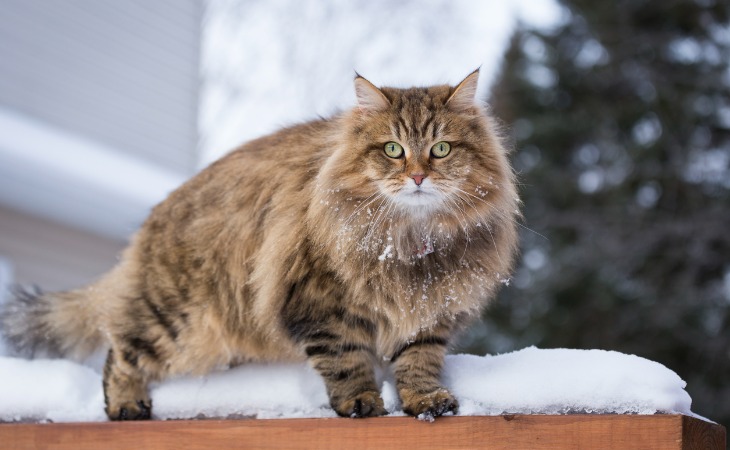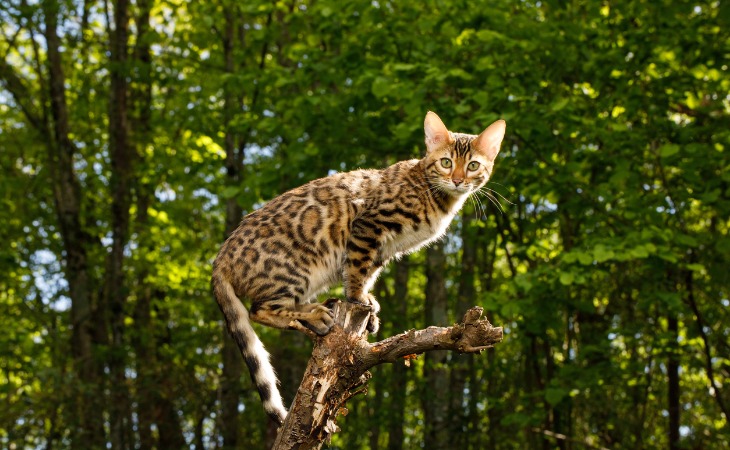Do you dream of adopting a cat but are scared that you won’t have enough time for them or that they will be bored without you? Luckily for you, there are many breeds that love spending time outdoors! That’s right, there are several outdoor cat breeds with very different personalities and physical characteristics. Here is a list of 10 cat breeds that love the outdoors.
Outdoor cat breeds from the North: resistant to the cold!
While all cats have some fur, some are better able to withstand the cold than others and can more easily walk around outside when temperatures are low.
The Norwegian Forest cat: a Viking cat
Just as its name suggests, the Norwegian Forest cat traces its origin to Norwegian forests. It is a wonderful outdoor cat. This cat breeds has a double layer cat with long hair and a lot of muscles to allow it to resist the cold. The Norwegian Forest cat is also one of the largest cats in the world, measuring 35 to 40 cm ( ≈ 13.7 to 15.7 in) long. As with most animals physiologically adapted to the cold, its coat sheds twice a year, as the seasons change. A hunter at heart, this cat loves to run and jump outside in the open air. In addition, while it is a very independent cat, it is still very affectionate.
The Maine Coon: an international star
This cat is one of the most popular cat breeds. It looks quite similar to the Norwegian Forest cat, especially because of its large size and long hair. As its name suggests, the Maine Coon comes from Maine, in the northern United States. This breed is very sociable, gets along wonderfully with children and other animals, and appreciates going out regularly to exercise. In addition, this cat’s hunting instincts make it want to go outside often. This cat is very widespread throughout the world. The Maine Coon is very intelligent with a calm and affectionate personality.
The Siberian: an easygoing cat breed
Siberian cats are among the most admired cat breeds because of the purity of their breed. They originated in Siberia decades ago and developed without any human intervention. Bred since the 80s, these cats fascinate people because of their extremely easygoing personality. In addition, as this breed is very close to nature, they feel a deep need to spend days and nights outside. With that being said, they always return to their owner because they are very attached to them. Similar to the Maine Coon and the Norwegian Forest cat, the Siberian has a long coat that keep it warm in the winter and protects it from the strong rays of the summer sun.
Oriental breeds: elegant and intelligent felines
Some cat breeds that are highly adapted to the outdoors have kept characteristics of wild cats, which can be seen both in their coat and in their behavior.
The Bengal : the domesticated tiger
This Bengal resulted from the crossing between a domestic cat and a leopard cat from Southeast Asia. It resulted from an experiment made by geneticist Jean Mill. She wanted to create a domestic cat with an impressive feline appearance.
Bengals are undeniably outdoor cats. Because of their wild origins, they are real balls of energy. Climbers at heart, they also love to swim and play in water.
The Burmese: the Asian lucky charm
Originating from Thailand and Burma, this cat breed is recognized for its grace, like the Siamese. The Burmese has a silky, shiny, and fine coat. Very lively and energetic, this cat must be able to go out to stretch its legs frequently in the garden. In addition, this cat is intelligent and fiery and could not be limited to a life in apartment because it needs to move outdoors! This cat also feels a constant need for stimulation, so it will be happy to be able to spend time with another cat. Additionally, as this cat is very close to humans, it is considered a good luck charm.
The Korat : the color of rain clouds
The Korat is also from Thailand and is also considered a good luck charm. This breed is rare and remarkably elegant. Long revered in its country of origin, the color of its coat is nicknamed “rain cloud gray”. This cat’s silver-blue coat will undoubtedly amaze its owners. Very attached to his owners, the breed is particularly affectionate and playful. Its constant need for intellectual stimulation makes it extremely sociable. In addition, this cat enjoys living with another cat. Because this cat has a lot of energy, it likes to spend time outdoors! It cannot handle being forced to stay within four walls for very long and needs a space outdoors to blossom.

Outdoor cat breeds from other parts of the world
There are also many cat breeds from other parts of the world that prefer to spend time outdoors! Here are just a few of them!
The Abyssinian: Egyptian elegance
The Abyssinian originated in Egypt and is one of the oldest known cat breeds. Their athletic bodies and long, tapered ears give Abyssinians a very slender and elegant appearance. In addition, their shiny fur and natural grace make them highly sought after. The Abyssinian also has a strong need to be physical active. It must be able to go out, run, and climb very often. If the breed doesn’t have the opportunity to spend time outdoors, it could become unbearable or depressed. Additionally, the Abyssinian is very playful, deeply attached to its owner, and loves cuddles and affection. The Abyssinian also does not like to be alone. It’s a good idea to adopt a second cat for your Abysinnian to spend time with if you are unable to spend a lot of time at home playing with your cat.
The British Shorthair: loyal and affectionate
Known for its calm and gentle personality, this cat is also very independent. This cat shares some similarities with the Chartreux and the Russian Blue because of its short and soft grey coat. Similar to the Bengal cat, the British Shorthair was created by humans. It was the product of a genetic experiment. Resulting from the crossing of alley cats with Persians, this species originated in England in the 19th century.
It is the ideal companion for elderly people because it is particularly loyal and affectionate. However, it does like to go out to hunt. The British Shorthair thrives in farms out in the country where it can play with its owner but also go out to get some fresh air when it wants. Its hunting instinct makes it to want to leave the house regularly to explore new horizons.
The European Shorthair: particularaly affectionate
While this cat breed is often confused with alley cats, the European Shorthair is a breed in its own right! This domestic cat comes from Scandinavia. Its coat can be black, white, or red and its eyes are usually blue or orange. While this cat is particularly affectionate and attached to its owner, it can quickly become unhappy without an outdoor space. A garden is its ideal playground. This breed loves hunting and enjoys going outside to test out these skills. For a European Shorthair to live happily, it needs access to the outdoors and a loving owner who can spend a good amount of time with it.
The Oriental Shorthair: the Greyhound cat
This cat breed has unique physical characteristics. Because of their tiny heads and long, triangular ears, these cats are often compared to Greyhounds. They are also extremely lively with a strong character! Like the Siamese, the Oriental Shorthair is very possessive and can be considered quite clingy. For this reason, it’s best not to leave this cat alone. We recommend finding another companion for your Oriental Shorthair, whether it’s dog or another cat. This playful and determined cat, often tries to test its owner’s limits very early on. Therefore, don’t hesitate to be firm when training it. In addition, the Oriental Shorthair’s athletic body requires a lot of physical exercise. They are very energetic and like to go outside to train for hunting or running. A garden is perfect for them.

